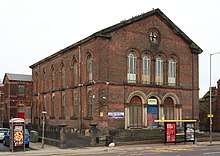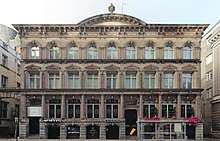James Picton
Sir James Allanson Picton (2 December 1805 – 15 July 1889) was an English antiquary and architect who played a large part in the public life of Liverpool. He took a particular interest in the establishment of public libraries.
James Picton | |
|---|---|
 Bust of Picton on the north side of the Picton Reading Room | |
| Born | James Allanson Picton November 2, 1805 |
| Died | July 15, 1889 (aged 83) |
| Nationality | English |
| Occupation | Architect |
James Picton was born in Liverpool to William Picton, a joiner and timber merchant, and entered his father's business at the age of 13. He later joined the office of Daniel Stewart, an architect and surveyor, eventually taking over the business. Picton designed some important buildings in Liverpool, including the corn exchange and Richmond Buildings, an office block, now demolished.[1]
He became a member of the town council in 1849, and in 1851 a member (and later chairman) of the Wavertree local board. He started to campaign for a public library for the borough and in 1852 an Act of Parliament was obtained to allow the raising of a penny rate for a public library and museum. William Brown provided the buildings for the library and museum in 1860. In 1879 the corporation added to the library a reading room which was called the Picton Reading Room, modelled on the British Museum Reading Room. Picton was the first chairman of the library and museum committee, which was founded in 1851, and he remained in this position until his death.[1]
Picton married Sarah Pooley. Their son also James Allanson Picton eschewed his father's architectural practice and was eventually elected as MP for Leicester.
Architectural works
Key
| Grade | Criteria[2] |
|---|---|
| Grade II* | Particularly important buildings of more than special interest. |
| Grade II | Buildings of national importance and special interest. |
Works
| Name | Location | Photograph | Date | Notes | Grade |
|---|---|---|---|---|---|
| 8–10 Brougham Terrace | West Derby Road, Liverpool 53.4143°N 2.9609°W |
— |
c. 1830 | The remaining part of a row of houses.[3] | — |
| Holy Trinity Church | Hoylake, Merseyside | — |
1833 | A new church in Neo-Norman style, since demolished.[4] | — |
| Congregational Church | Crow Lane, Newton-le-Willows, Merseyside |
— |
1842 | A plain simple church with lancet windows, a wheel window, and twin porches facing the road. It was later used by the United Reformed Church, and closed in 2005, with planning to convert it into residential accommodation.[5] | — |
| Chorlton Hall | Backford, Cheshire 53.2392°N 2.8891°W |
— |
1845–46 | Extension of an 18th-century house for James Wickstead Swan.[6][7][8] | II |
| Sandy Knowe | Wavertree, Liverpool 53.4030°N 2.9135°W |
— |
1847 | A red sandstone house built for himself in Jacobean style. It has an L-plan, with an octagonal turret at the junction. The house also has shaped gables, finials, and mullioned windows.[9][10] | II |
| 11 Dale Street[lower-alpha 1] | Liverpool 53.4076°N 2.9902°W |
 |
1859 | An office built for the Queen Insurance Company. It has six bays facing Dale Street and five bays on Hackings Hey, and is in three storeys with a basement. There are round-headed windows in the lower and top floors. The windows in the middle storey have architraves with pilasters. Between the middle and top storeys are balustraded balconies. At the summit of the building is a heavy cornice with curved machicolations.[11][12] | II |
| Hargreaves Building | 5 Chapel Street, Liverpool 53.4073°N 2.9942°W |
 |
1859 | This was built as the headquarters of the banker Sir William Brown. It has three storeys and a basement, and is designed in the style of a Venetian palazzo. Between the heads of the ground floor windows are roundels containing carvings of people involved with the exploration of the Americas. Between 1895 and 2001 it was used by the Liverpool Racquet Club, and has since been converted into a hotel and restaurant.[13][14][15] | II |
| St Bartholomew's Church | Arborfield, Berkshire 51.4043°N 0.9118°W |
 |
1863 | A new church in Gothic Revival style replacing an older church nearby. It is in flint with stone dressings and a tiled roof. The church has a west tower with a broach spire, and an apsidal chancel.[16] | II |
| Richmond Baptist Church | Breck Road, Liverpool 53.4245°N 2.9554°W |
 |
1864 | A chapel in brick with stone dressings and a slate roof. It has two storeys. The lower storey of the entrance front has three arched doorways, above which are four round-headed windows, and a rose window in the gable. There are more round-headed windows along the sides in two tiers. Inside the chapel there are galleries on all four sides.[17] | II |
| Mercantile and Exchange Bank | 48–50 Castle Street, Liverpool 53.4057°N 2.9907°W |
— |
1864 | A tall, narrow building, with red granite columns framing the ground floor windows, and lunettes in the first floor.[18] | — |
| The Temple | 22A and 24 Dale Street, Liverpool 53.4077°N 2.9890°W |
— |
1864–65 | This was built as an office for Sir William Brown. It originally had two ranges leading from the back of the building; the east range has been demolished, and the west range converted into flats. It is in three storeys plus a basement and attic, and has a Mansard roof. There are seven bays facing Dale street, and a curved bay leading round into Princess Street.[12][19][20] | II |
| Fowler's Buildings | 1–3 Temple Lane and 3–9 Victoria Street, Liverpool 53.4067°N 2.9883°W |
 |
1865–69 | This was built as offices for the Fowler brothers, who were produce dealers. The main front on Victoria Street has three storeys and a basement, and is in nine bays. On the main floor are polished granite columns, and above the window surrounds are "curvy". Behind, along Temple Lane, is a five-storey, 14-bay warehouse in polychromic brick.[21][22][23] | II* |
| Picton Clock Tower | Wavertree, Liverpool 53.3982°N 2.9158°W |
 |
1884 | Erected by Picton as a memorial to his wife. It now stands surrounded by a roundabout. The tower is in three stages with a clock face in each of its four sides. At the top is a lead cupola with a short spire. Around the base are four iron lamp posts.[24][25] | II |
| Lock up | Childwall Road, Wavertree, Liverpool 53.3983°N 2.9144°W |
 |
Undated | Picton added a pyramidal slate roof and a weathervane to a lock-up built in 1796, which stands at a confluence of roads. It is an octagonal stone structure in two storeys.[26] | II |
| Corn Exchange | Fenwick Street, Liverpool 53.4055°N 2.9920°W |
— |
Undated | Replaced by a new building in 1953–59.[27] | — |
Notes
- For the same building at this address, the National Heritage List states it was built in 1868, and calls it the Union Marine Buildings.[11]
References
- C. W. Sutton, ‘Picton, Sir James Allanson (1805–1889)’, Oxford Dictionary of National Biography, Oxford University Press, 2004 , accessed 11 January 2009
- Listed Buildings, Historic England, retrieved 27 March 2015
- Sharples & Pollard (2004), p. 268
- Hartwell et al. (2011), p. 405
- Pollard & Pevsner (2006), p. 526
- Hartwell et al. (2011), p. 129
- de Figueiredo & Treuherz (1988), p. 224
- Historic England, "Chorlton Hall (1130682)", National Heritage List for England, retrieved 3 December 2012
- Pollard & Pevsner (2006), p. 499
- Historic England, "Sandy Knowe, Liverpool (1363073)", National Heritage List for England, retrieved 25 November 2012
- Historic England, "Union Marine Buildings, 11 Dale Street, Liverpool (1068273)", National Heritage List for England, retrieved 25 November 2012
- Sharples & Pollard (2004), p. 146
- Sharples & Pollard (2004), pp. 19, 140
- Pye (2011), p. 78
- Historic England, "Hargreaves Building, Liverpool (1068348)", National Heritage List for England, retrieved 25 November 2012
- Historic England, "Church of St Bartholomew, Arborfield and Newland (1135983)", National Heritage List for England, retrieved 25 November 2012
- Historic England, "Richmond Baptist Church, Liverpool (1068353)", National Heritage List for England, retrieved 25 November 2012
- Sharples & Pollard (2004), p. 138
- Pye (2011), p. 84
- Historic England, "The Temple, Dale Street, Liverpool (1206475)", National Heritage List for England, retrieved 25 November 2012
- Sharples & Pollard (2004), pp. 21, 165
- 3–9 Victoria Street, Liverpool, Looking at Buildings, retrieved 25 November 2012
- Historic England, "Fowler's Buildings, Liverpool (1063294)", National Heritage List for England, retrieved 25 November 2012
- Pollard & Pevsner (2006), p. 497
- Historic England, "Clock tower and four iron lamps, Liverpool (1206131)", National Heritage List for England, retrieved 25 November 2012
- Historic England, "Lock up, Childwell, Liverpool (1068320)", National Heritage List for England, retrieved 25 November 2012
- Sharples & Pollard (2004), p. 151
Bibliography
- de Figueiredo, Peter; Treuherz, Julian (1988), Cheshire Country Houses, Chichester: Phillimore, ISBN 0-85033-655-4
- Hartwell, Claire; Hyde, Matthew; Hubbard, Edward; Pevsner, Nikolaus (2011) [1971], Cheshire, The Buildings of England, New Haven and London: Yale University Press, ISBN 978-0-300-17043-6
- Pollard, Richard; Pevsner, Nikolaus (2006), Lancashire: Liverpool and the South-West, The Buildings of England, New Haven and London: Yale University Press, ISBN 0-300-10910-5
- Pye, Ken (2011), Discover Liverpool, Liverpool: Trinity Mirror Media, ISBN 978-1-906802-90-5
- Sharples, Joseph; Pollard, Richard (2004), Liverpool, Pevsner Architectural Guides, New Haven and London: Yale University Press, ISBN 0-300-10258-5
| Wikimedia Commons has media related to James Picton. |